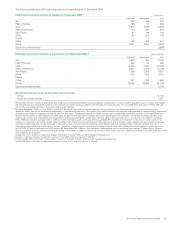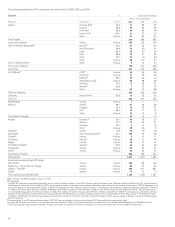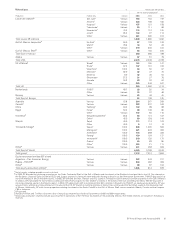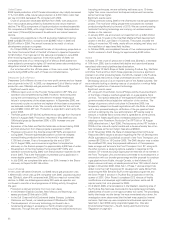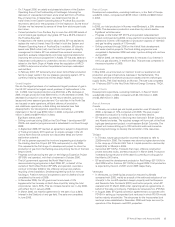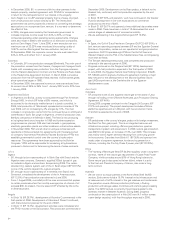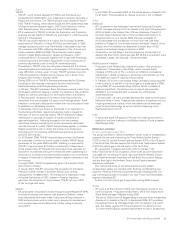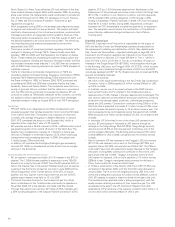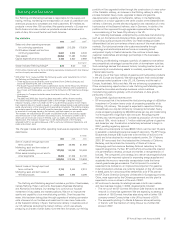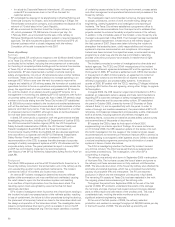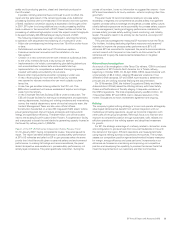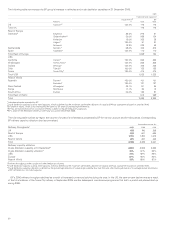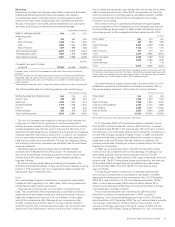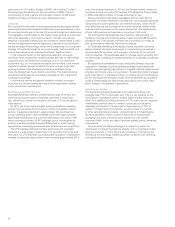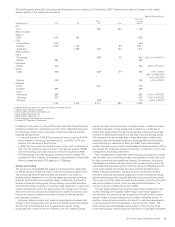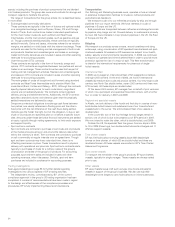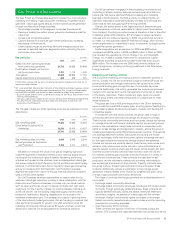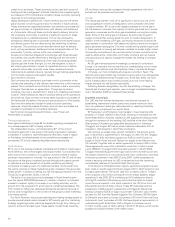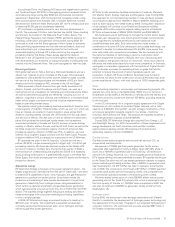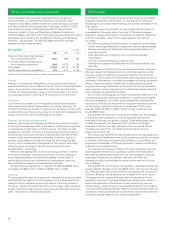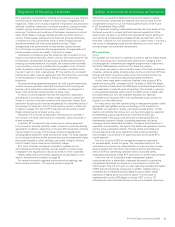BP 2006 Annual Report Download - page 31
Download and view the complete annual report
Please find page 31 of the 2006 BP annual report below. You can navigate through the pages in the report by either clicking on the pages listed below, or by using the keyword search tool below to find specific information within the annual report.safely and is producing gasoline, diesel and chemicals products for
the US market.
In parallel, refinery personnel have continued to work to effect the
repair and the safe restart of the remaining process units. Additional
processing facilities were commissioned in the second and third quarters
of 2006. Additional conversion capacity is expected to be brought online
in 2007. BP’s plan is to bring additional sour crude processing facilities
back on-stream in the second half of 2007; these facilities will allow the
processing of additional high-sulphur crude. We expect crude throughputs
to be approximately 400,000 barrels per day by the end of 2007.
The following milestones have been achieved in returning the refinery
to operation with sequenced reconditioning of a multitude of units:
– Major site commissioning involving more than 15 million worker hours
to date.
– Refurbishment and safe start-up of 27-mile steam system.
– Extensive mechanical renovation and the installation of a new
flare system.
– Creation of a new command centre with interactive audio/visual links
to the units, manned 24 hours a day during unit start-up.
– Implementation of a holistic commissioning plan defining behaviours
and accountabilities to deliver safe and successful start-up.
– Implementation of a comprehensive systems training programme,
coupled with safety accountability roll-out plans.
Several other improvements are either complete or under way:
– A new office building for more than 400 Texas City workers
was opened to relocate workers who can work outside our plant
fence line.
– A new flue gas scrubber is being added to the FCC unit. This
$80-million investment will reduce emissions of sulphur and nitrogen
oxide from the refinery.
– A new Employee Services Building (ESB) is under construction. The
ESB will include facilities for learning and development and operations
training departments, including unit training simulators and nine training
rooms, the medical department, some of the site’s security team, the
Incident Management Team and site union official offices.
Construction has started on a new 250 megawatt (MW) steam turbine
power generating plant that will reduce emissions and improve both
energy and operational efficiency. The $100-million unit will be located
next to the existing South Houston Green Power LP co-generation facility
and is expected to boost the total electricity generating capacity located at
the Texas City refinery site to 1,000MW.
Report of the BP US Refineries Independent Safety Review Panel
On 16 January 2007, having completed its review, the panel issued its
report. The report identified deficiencies in process safety performance
at BP’s US refineries and called on BP to give process safety the same
priority that it had historically given to personal safety and environmental
performance. In making its findings and recommendations, the panel
stated its objective was excellence in process safety performance, not
simply legal compliance. The panel specifically noted that, ‘during the
course of its review, it saw no information to suggest that anyone – from
BP’s board members to its hourly workers – acted in anything other than
good faith.’
The panel made 10 recommendations relating to: process safety
leadership; integrated and comprehensive process safety management
system; process safety knowledge and expertise; process safety culture;
clearly defined expectations and accountability for process safety; support
for line management; leading and lagging performance indicators for
process safety; process safety auditing; board monitoring; and industry
leader. The panel’s report in its entirety can be found at www.bp.com/
bakerpanelreport.
The panel acknowledged the measures BP had taken since the Texas
City incident, including dedicating significant resources and personnel
intended to improve the process safety performance at BP’s US
refineries. BP has committed to implement the panel’s recommendations
and will consult with the panel on how best to do this across the US
refineries and to apply the lessons learned elsewhere in its global
operations.
Other refinery investigations
As a result of its investigation of the Texas City refinery, OSHA conducted
an inspection of BP Products North America Inc.’s Toledo refinery,
beginning in October 2005. On 24 April 2006, OSHA issued citations with
a total penalty of $2.4 million, alleging 39 separate violations of two
different OSHA standards. BP and OSHA have reached a settlement in
principle and are working towards finalizing the documentation.
On 15 November 2006, the Indiana Occupational Safety and Health
Administration (IOSHA) issued the Whiting refinery with three Safety
Orders and Notifications of Penalty alleging 14 separate violations of
the OSHA regulations. The total proposed penalty was $0.4 million. On
7 December 2006, BP and IOSHA met to discuss resolution of the
matter. Discussions to reach a settlement agreement are ongoing.
Refining
The company’s global refining strategy is to own and operate strategically
advantaged refineries that benefit from vertical integration with our
marketing and trading operations, as well as horizontal integration with
other parts of the group’s business. Refining’s focus is to maintain and
improve its competitive position through sustainable, safe, reliable and
efficient operations of the refining system and disciplined investment
for growth.
For BP, the strategic advantage of a refinery relates to its location, scale
and configuration to produce fuels from low-cost feedstocks in line with
the demand of the region. Efficient operations are measured primarily
using regional refining surveys conducted by third parties. The surveys
assess our competitive position against benchmarked industry measures
for margin, energy efficiency and costs per barrel. Investments in our
refineries are focused on maintaining and improving our competitive
position and developing the capability to produce the cleaner fuels that
meet the requirements of our customers and their communities.
BP Annual Report and Accounts 2006 29


